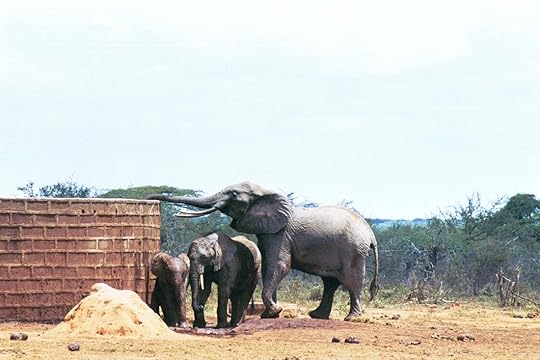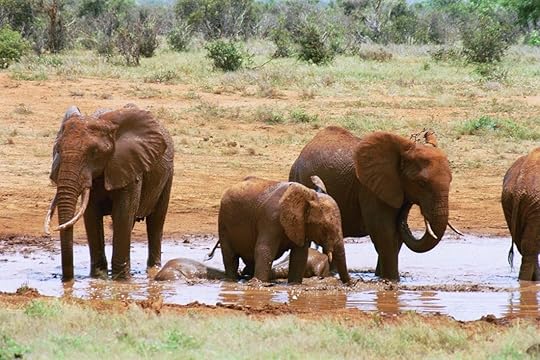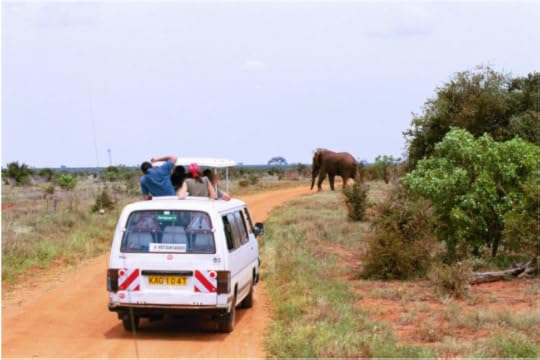Elephants.

 I never thought that I would fall in love with elephants but it happened on our first night.
I never thought that I would fall in love with elephants but it happened on our first night.I met them in Tsavo National Park in Kenya in 2000. My husband, John, and I had volunteered for an EarthWatch project to help with their study of patterns of elephant migration. We had spent the heat of the first afternoon in camp listening to Dr. Barbara McKnight, the biologist who was leading the field research, explain what our duties would be in the coming weeks.
She told us that the elephants moved from Tsavo East to Tsavo West and back again twice a year. During those migrations they crossed some agricultural land and caused a considerable amount of damage to the crops and to the water storage containers on the farms. Although this damage made the farmers fighting mad the government knew that thousands of tourists would spend a lot of money to see elephants. Our research project was aimed to design a wildlife management system that would balance the needs of the elephants to the well being of the farmers.
Our job as volunteers would be to identify as many elephants as we could and, as this was many years before digital photography and face-recognition software had been invented, we would be using photographic prints to track and identify individuals. We’d need to be very observant and to take accurate notes of distinguishing features. Specific tusks on an individual elephant might be broken, curved, splayed. It might have just one tusk or be tusk-less. We’d look for ears that were broken, notched, or had holes. All tails told a story; they could be twisted, have no hair or be missing the end. An elephant’s trunk could be perfect, or cut or have its tip missing. We had to look at all of the elephant’s body and look for abnormal growths or scars. Dr. McKnight kept a database of each individual elephant and updated it with our notes, photographs, locations and activity. She also tracked reproduction records like musth cycles of the males and the offspring of the females including birth date, sex and survival.
The first evening, John and I, together with Mary (another volunteer) and Chenge, our African driver and biologist, drove out to a water storage tank a couple of hours before sunset and waited for the elephants. Chenge stopped the jeep in a clearing in the bush about fifty yards from the storage tank and told us to stay perfectly still and silent for as long as it took for the elephants to come. No air moved. It was hot. We waited and waited and waited. I glanced at my watch and saw it was less than half an hour before sunset, but nothing was happening. Then they appeared and walked right beside the vehicle. These huge grey animals moved silently out of the bush, shuffled past us without a sound and headed for the water tank.
As they moved past us we could smell that earthy smell they have, look up into their black eyes and listen as they grunted, chirped and squeaked to each other. We totally forgot to try and identify any individuals as we had been asked to. We were just enthralled with being in the middle of twenty or so females and children as they drank from the tanks and stood around socializing. Suddenly, a couple of the young males became a little amorous and started trying to mount their female cousins. Then all hell broke loose as the older females chased the young males away with threshing trunks and a cacophony of trumpeting. That’s a sound and a sight that I’ll never forget
On that first night, as we had a front row seat of their evening ritual, Chenge explained to us that elephants live in two distinct groups. The females and the youngsters travel together and are led by the oldest female, the matriarch, and all mature females take an active part in raising the offspring. These groups range in size from six to more than twenty. When the young males approach puberty, at between twelve and fifteen years of age, the females push them out of the group and they will then join a band of bulls.
Elephants are complex, they like contact, often touching one another. They vocally communicate and even even purr from joy. They play, they practice mating, charging and fighting, especially the young males.
Once they have reached puberty, males are sexually active for periods of about three months. This is known as “being in musth”. Their temporal glands, which are located on each side of the head between the eye and the ear, become swollen and excrete a strong smelling fluid of rich testosterone, which runs down their cheeks. During musth the males are very aggressive and unpredictable.
One evening, we had stopped the jeep and were watching a group of elephants bathing. The larger elephants walked into the mud pool, sucked up the water in their trunks and then threw it onto their backs and underneath, onto their bellies. The teenagers of the group followed them into the pool and eventually the mothers and aunts encouraged the little ones to come in. However, they were unsteady on their feet and fell down. But the adults gently helped them scramble back on their feet.
We were all absorbed in watching this family, trying to identify and photograph them, when, suddenly across the plains came this lone massive bull in musth. As he got closer and closer we could see that his cheeks and thighs were covered with fluid. My heart was pounding as he came menacingly towards us and Chenge, our driver, decided it was time for us to leave. He turned ignition key but the engine would not start. It just sputtered and died.
Oh no! There was this majestic elephant in full musth, standing with his four feet firmly on the ground, his trunk swaying from side to side and staring at us. He was, maybe, twenty-five yards away. Chenge whispered to us that we had two options; a couple of people could get out and try to jump-start the jeep, or we could sit quietly, not move and simply watch his behaviour! We chose the second option. Chenge whispered that because the bull’s trunk that was rocking from side to side it meant he was deciding between attack and retreat. Really I thought! This swinging was becoming bigger and more frantic. But we had previously learned that this was his way of displaying a threat and the more impressive it was the less likely he was to charge. Well, that was good news! He moved at us in a sort of “mock charge” and stopped a few feet from us, which was very unnerving for us all. His ears flared, his trunk swung and now he was swinging one foot. After a minute or two he slowly turned away from our vehicle and wandered on, northwards across the plains. Chenge designated a couple of people to hop out and push the jeep to jump-start it and, much to our relief the engine coughed to life. We drove south!
That wasn't the only time we encountered an aggressive bull; it was just part of living in Kenya. What a remarkable trip this was. It gave us the opportunity to live in tents, see the sun rise on the African plains, experience elephants, lions, giraffes and other animals and to love a life of adventure and new experiences.

Published on August 29, 2016 09:00
No comments have been added yet.



